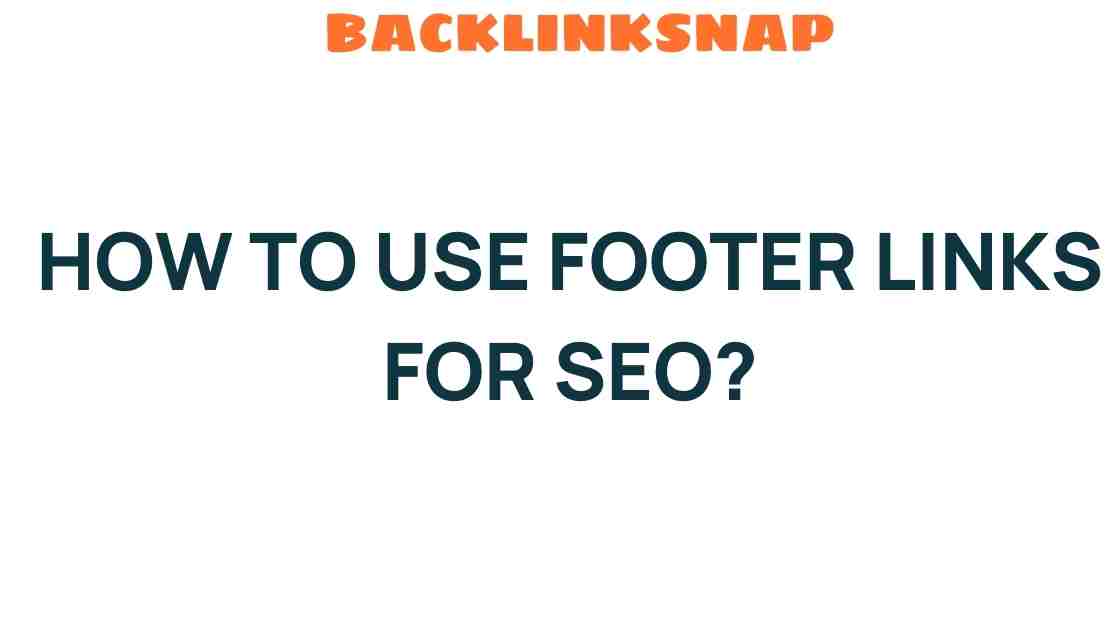In the vast landscape of digital marketing, where every pixel counts, footer links often fly under the radar. However, these seemingly mundane elements hold significant potential for enhancing your SEO strategy, improving website optimization, and ultimately boosting your search engine ranking. This article dives into the importance of footer links, how they can be leveraged for better internal linking, and the positive impact they can have on user experience and site navigation.
Footer links are typically located at the bottom of a webpage and serve multiple purposes. They can include links to important pages such as your privacy policy, terms of service, contact information, and even links to your main site categories or popular blog posts. While they may not be the first thing a visitor sees, they play a crucial role in how search engines view your site.
When properly utilized, footer links can help distribute link equity throughout your website. This is vital for pages that may not receive as much direct traffic but are essential for your overall site structure and SEO. By incorporating relevant keywords in your footer links, you can enhance the contextual relevance of those pages, thereby potentially improving their search ranking.
One of the primary benefits of footer links is their ability to enhance user experience and improve site navigation. Imagine a visitor scrolling to the bottom of your page and finding a well-organized footer with links to the information they need. This not only facilitates easier navigation but also encourages users to explore more of your site, increasing their time on site and reducing bounce rates.
Here are some best practices for optimizing your footer links:
- Be selective: Don’t overcrowd your footer with too many links. Instead, choose the most important pages that align with your user’s needs.
- Organize logically: Group similar links together to enhance clarity. For instance, categorize links under headings like “Customer Service,” “Legal,” and “Resources.”
- Use descriptive anchor text: Instead of generic “click here” text, use descriptive phrases that give users a clear idea of what to expect.
Link equity refers to the value passed from one page to another through hyperlinks. It plays a crucial role in determining how well a page ranks in search engine results. Footer links can be a strategic way to distribute this equity throughout your website. For instance, if your homepage has a high authority due to backlinks and engagement, linking to less authoritative pages in the footer can help them gain traction.
Moreover, search engines like Google use algorithms that analyze the structure of your site. By strategically placing footer links to important pages, you can signal to search engines that these pages are valuable and relevant, which can positively affect their ranking.
To unlock the full potential of footer links within your SEO strategy, consider the following steps:
- Identify key pages: Analyze your website analytics to determine which pages need more visibility or traffic.
- Integrate keywords: Use relevant keywords in the anchor text of your footer links to enhance contextual relevance.
- Monitor performance: Regularly check the performance of your footer links using tools like Google Analytics to see how they contribute to traffic and engagement.
As you implement these strategies, remember that consistency is key. Regular updates and optimizations based on user behavior and SEO trends will ensure that your footer links remain effective.
Many successful brands utilize footer links effectively. For example, e-commerce sites often include links to their return policy, shipping information, and contact details in the footer. This not only helps users find essential information but also enhances their trust in the brand.
Blog websites often link to popular posts or categories in their footer, encouraging visitors to explore more content. This not only improves the user experience but also increases the chances of those pages being indexed and ranked by search engines.
While footer links can be beneficial, there are common pitfalls to avoid:
- Overloading with links: Too many links can overwhelm users and dilute the value of each link.
- Neglecting mobile optimization: Ensure your footer links are easily accessible on mobile devices, as a significant portion of web traffic comes from smartphones.
- Ignoring analytics: Failing to analyze the performance of your footer links can lead to missed opportunities for optimization.
Footer links are hyperlinks located at the bottom of a webpage, often directing users to important pages like privacy policies, contact information, and main site categories.
Footer links help distribute link equity across your website, enhance site navigation, and improve user experience, all of which contribute positively to SEO.
Yes, using relevant keywords in your footer links can enhance the contextual relevance of the linked pages, potentially improving their search rankings.
Focus on being selective with your links, organizing them logically, and using descriptive anchor text for optimal user experience and SEO benefits.
Yes, effective footer links can encourage users to explore more of your site, potentially reducing bounce rates and increasing engagement.
Regularly update your footer links based on user behavior and changes to your site structure to ensure they remain relevant and effective.
Conclusion
In conclusion, footer links are an often-overlooked yet powerful tool in your SEO strategy. By understanding their impact on user experience, site navigation, and link equity, you can harness their potential to improve your website’s performance. Remember that a well-structured footer not only benefits your SEO efforts but also enhances the overall experience for your visitors. As you integrate footer links into your site, keep testing and refining your approach to ensure lasting success.
For more insights on optimizing your website, check out this comprehensive guide. And for further reading on digital marketing strategies, visit this resource.
This article is in the category SEO Optimization and created by BacklinkSnap Team




